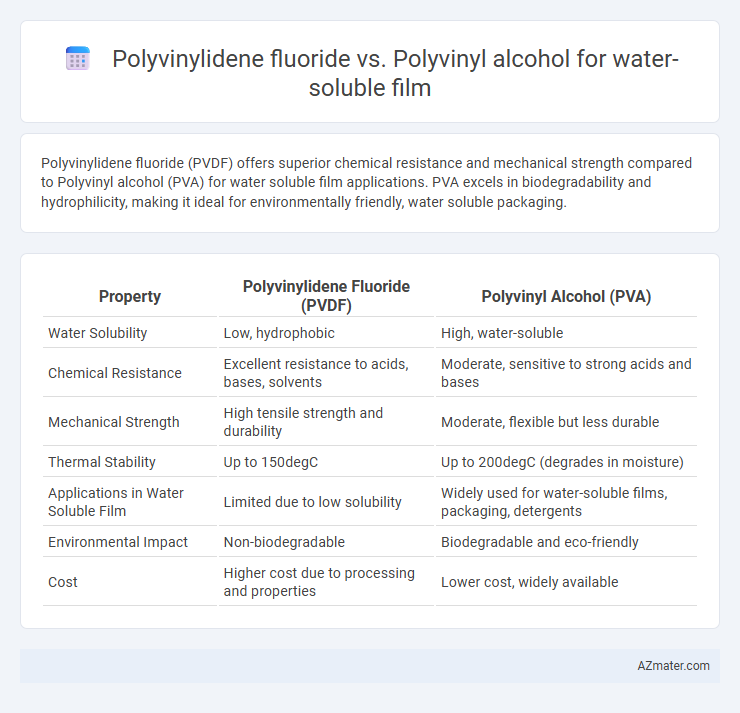Polyvinylidene fluoride (PVDF) offers superior chemical resistance and mechanical strength compared to Polyvinyl alcohol (PVA) for water soluble film applications. PVA excels in biodegradability and hydrophilicity, making it ideal for environmentally friendly, water soluble packaging.
Table of Comparison
| Property | Polyvinylidene Fluoride (PVDF) | Polyvinyl Alcohol (PVA) |
|---|---|---|
| Water Solubility | Low, hydrophobic | High, water-soluble |
| Chemical Resistance | Excellent resistance to acids, bases, solvents | Moderate, sensitive to strong acids and bases |
| Mechanical Strength | High tensile strength and durability | Moderate, flexible but less durable |
| Thermal Stability | Up to 150degC | Up to 200degC (degrades in moisture) |
| Applications in Water Soluble Film | Limited due to low solubility | Widely used for water-soluble films, packaging, detergents |
| Environmental Impact | Non-biodegradable | Biodegradable and eco-friendly |
| Cost | Higher cost due to processing and properties | Lower cost, widely available |
Introduction to Water Soluble Films
Water soluble films are thin, flexible materials that dissolve in water, commonly used for packaging applications like laundry detergents and agrochemicals. Polyvinylidene fluoride (PVDF) offers excellent chemical resistance and mechanical strength but is less commonly used for water soluble films due to its hydrophobic nature. Polyvinyl alcohol (PVA) remains the preferred polymer for water soluble films thanks to its exceptional water solubility, biodegradability, and film-forming properties, making it ideal for environmentally friendly and efficient packaging solutions.
Overview of Polyvinylidene Fluoride (PVDF)
Polyvinylidene fluoride (PVDF) is a highly non-reactive and pure thermoplastic fluoropolymer known for its exceptional chemical resistance, strong mechanical properties, and excellent thermal stability, making it ideal for water soluble film applications requiring durability and chemical inertness. PVDF films exhibit low water absorption and superior resistance to solvents, acids, and bases compared to polyvinyl alcohol (PVA), which enhances their performance in harsh environmental conditions. In contrast to PVA's high water solubility, PVDF's semi-crystalline structure provides controlled solubility and greater longevity in water contact scenarios.
Overview of Polyvinyl Alcohol (PVA)
Polyvinyl Alcohol (PVA) is a highly water-soluble polymer widely used in water soluble films due to its excellent film-forming, emulsifying, and adhesive properties. It offers strong chemical resistance, biodegradability, and is non-toxic, making it suitable for packaging applications in pharmaceuticals, agriculture, and detergents. Compared to Polyvinylidene Fluoride (PVDF), PVA films dissolve rapidly in water, enabling precise release of active ingredients without compromising film integrity.
Chemical Structure Comparison: PVDF vs PVA
Polyvinylidene fluoride (PVDF) features a highly stable fluorinated polymer backbone with repeating units of -(CH2-CF2)-, providing excellent chemical resistance and hydrophobicity essential for durable water-soluble films. In contrast, polyvinyl alcohol (PVA) consists of -(CH2-CHOH)- units, characterized by hydroxyl groups that confer hydrophilicity and facilitate water solubility through hydrogen bonding. The fundamental difference in chemical composition--fluorinated PVDF versus hydroxyl-rich PVA--directly impacts solubility, mechanical properties, and environmental interactions in water-soluble film applications.
Water Solubility and Dissolution Rate
Polyvinyl alcohol (PVA) offers superior water solubility and a faster dissolution rate compared to polyvinylidene fluoride (PVDF), making it ideal for water soluble film applications requiring rapid disintegration. PVDF, being hydrophobic and chemically resistant, exhibits low water solubility and a significantly slower dissolution rate, limiting its use in quick-dissolve films. Therefore, PVA's hydrophilic nature and efficient dissolution kinetics provide enhanced performance in water soluble packaging and coating technologies.
Mechanical Properties and Film Strength
Polyvinylidene fluoride (PVDF) exhibits superior mechanical properties with high tensile strength and excellent chemical resistance, making it suitable for durable water-soluble films in harsh environments. Polyvinyl alcohol (PVA) offers good film strength and flexibility but has lower tensile strength and chemical resistance compared to PVDF, which can limit its use to applications requiring moderate mechanical durability. The choice between PVDF and PVA depends on the balance needed between film strength, flexibility, and environmental exposure conditions.
Thermal and Chemical Resistance
Polyvinylidene fluoride (PVDF) exhibits superior thermal resistance withstanding temperatures up to 150degC and exceptional chemical resistance against acids, bases, and solvents, making it ideal for demanding water soluble film applications. In contrast, Polyvinyl alcohol (PVA) offers moderate thermal stability, typically up to 85degC, and limited chemical resistance, particularly vulnerable to strong solvents and high pH environments. The choice between PVDF and PVA for water soluble films depends on the application's specific thermal and chemical exposure requirements, with PVDF providing enhanced durability in harsher conditions.
Environmental Impact and Biodegradability
Polyvinyl alcohol (PVA) offers superior biodegradability and lower environmental impact compared to polyvinylidene fluoride (PVDF), which is a fluoropolymer known for its chemical resistance but poor biodegradability. PVA films dissolve in water and degrade into non-toxic byproducts, making them more environmentally friendly for water-soluble film applications. In contrast, PVDF tends to persist in the environment due to its resistance to degradation and potential for fluorinated compound accumulation.
Cost Analysis and Market Availability
Polyvinylidene fluoride (PVDF) offers superior chemical resistance but comes at a higher cost compared to polyvinyl alcohol (PVA), which is more economical and widely used for water soluble films in packaging and agricultural applications. PVA demonstrates greater market availability due to its biodegradability and extensive industrial adoption, making it the preferred choice for cost-sensitive projects. While PVDF's niche applications justify its expense, PVA's balance of cost-effectiveness and accessibility drives its dominance in global water soluble film markets.
Applications and Industry Use Cases
Polyvinylidene fluoride (PVDF) offers excellent chemical resistance and mechanical strength, making it ideal for industrial applications such as protective coatings and membranes in harsh environments. Polyvinyl alcohol (PVA) is widely used in water soluble films for packaging, agriculture, and detergent pods due to its biodegradability and strong film-forming properties. Industries like pharmaceuticals, agriculture, and packaging leverage PVA for controlled release and eco-friendly single-use applications, while PVDF serves specialized roles in chemical processing and filtration systems.

Infographic: Polyvinylidene fluoride vs Polyvinyl alcohol for Water Soluble Film
 azmater.com
azmater.com